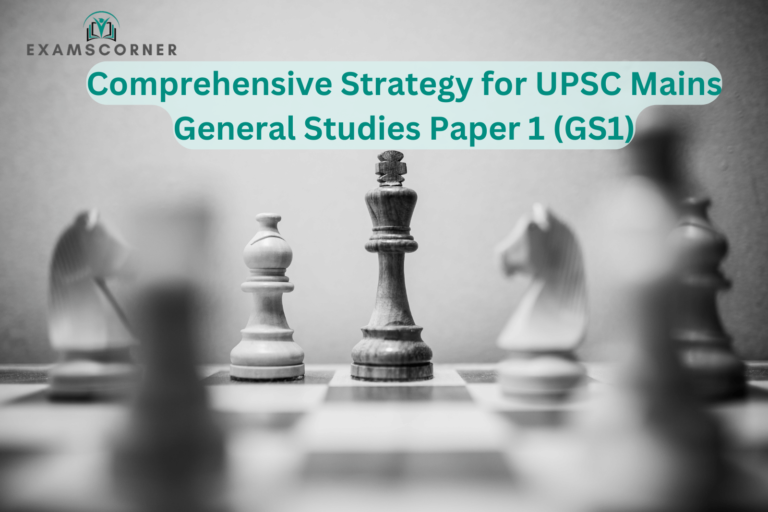Preparing for the UPSC Mains General Studies Paper 1 (GS1) requires a deep understanding of its syllabus, careful resource selection, and an effective preparation strategy. This article provides an exhaustive guide to acing GS1 by covering its topics, sub-topics, recommended book sources, analysis of previous year questions, and a detailed preparation strategy.
1. Understanding the GS1 Syllabus
GS1 encompasses Indian Heritage and Culture, History, Geography, and Indian Society. Each section demands specific focus areas, and understanding the syllabus in detail is crucial for targeted preparation.
A. Indian Heritage and Culture
Topics: Salient features of Indian art, architecture, literature, and culture from ancient to modern times.
Sub-Topics:
Performing Arts: Classical dances (Bharatanatyam, Kathak), folk traditions, and theatre forms.
Visual Arts: Sculptures, paintings (Mughal, Rajput), and modern artistic expressions.
Literature: Vedic texts, Sangam literature, Bhakti-Sufi traditions, and modern literary movements.
Architecture: Evolution from Harappan civilization to Mughal and colonial periods.
B. History
Topics: Modern Indian history, World history, and Post-Independence consolidation.
Sub-Topics:
Modern Indian History:
British expansion and policies: Doctrine of Lapse, Subsidiary Alliance.
Socio-religious reforms: Brahmo Samaj, Arya Samaj, Aligarh Movement.
National Movement: 1857 Revolt, Gandhian Era, Partition.
World History:
Industrial Revolution: Causes, spread, and consequences.
World Wars: Causes, significant events, and aftermath.
Colonization and Decolonization: Scramble for Africa, Asian independence movements.
Post-Independence Consolidation:
Reorganization of states, Five-Year Plans, political developments like Emergency, and coalition politics.
C. Geography
Topics: Physical geography, Human geography, and Geophysical phenomena.
Sub-Topics:
Physical Geography: Landforms, climate systems, and natural vegetation.
Human Geography: Resource distribution, industrial location factors.
Geophysical Phenomena: Earthquakes, tsunamis, volcanic activity, cyclones.
D. Indian Society
Topics: Diversity, globalization’s impact, and social empowerment.
Sub-Topics:
Salient features of Indian society: Unity in diversity, caste dynamics, and family structure.
Globalization’s impact: Cultural homogenization, socio-economic disparities.
Communalism, regionalism, and secularism: Challenges and solutions.
2. Recommended Book Sources
Here are the essential books and resources for GS1 preparation:
A. Indian Heritage and Culture
An Introduction to Indian Art – NCERT Class XI.
Indian Art and Culture by Nitin Singhania.
B. History
Modern Indian History:
A Brief History of Modern India by Spectrum Publications.
India’s Struggle for Independence by Bipan Chandra.
World History:
History of the World by Arjun Dev.
Relevant NCERT textbooks.
Post-Independence History:
India Since Independence by Bipan Chandra.
C. Geography
NCERT textbooks for Classes XI and XII.
Certificate Physical and Human Geography by G.C. Leong.
Atlas by Oxford or Orient BlackSwan for map-based learning.
D. Indian Society
NCERT Sociology textbooks for Classes XI and XII.
Social Problems in India by Ram Ahuja.
3. Analysis of Previous Year Questions
Analyzing previous year’s papers helps in understanding the pattern, nature, and weightage of topics:
Insights:
Questions on Indian art and culture often link with current affairs (e.g., GI tags, UNESCO heritage sites).
Modern Indian history dominates the history section, with significant weightage given to freedom struggle-related questions.
Geography questions focus on contemporary issues like resource management and climate change.
Indian society questions explore current social issues like women’s empowerment, urbanization, and regionalism.
Preparation Tips Based on Analysis:
Focus on linking static topics with contemporary developments.
Practice writing concise and relevant answers using previous year questions.
4. Comprehensive Preparation Strategy
A. Integrated Approach
Interlink topics across sections to build a multidimensional perspective.
Example: Study the cultural impacts of the freedom struggle while preparing for Modern Indian History.
B. Current Affairs Integration
Relate static syllabus topics with current events.
Example: Link questions on Indian architecture to current archaeological findings or UNESCO nominations.
C. Answer Writing Practice
Dedicate time to practicing previous years’ questions and mock tests.
Focus on structured answers with introductions, main body, and conclusions.
Use diagrams, maps, and flowcharts where applicable.
D. Effective Revision
Revise regularly to retain facts and figures.
Use one-pagers or flashcards for quick revision of key topics.
E. Time Management
Allocate specific time slots for each section based on weightage and personal strengths.
Prioritize weaker areas without neglecting stronger ones.
F. Resource Optimization
Stick to limited but reliable sources to avoid confusion and information overload.
Supplement with online resources like UPSC toppers’ blogs and government reports.
G. Mock Tests and Self-Assessment
Regularly evaluate progress through mock tests.
Analyze mistakes and improve on weak areas.
5. Conclusion
Mastering GS1 requires a balanced approach combining conceptual clarity, analytical skills, and answer-writing proficiency. By following this structured strategy and staying consistent with your preparation, you can confidently tackle the diverse questions posed in UPSC Mains GS1. Remember, the key to success lies in regular practice, timely revision, and an integrated understanding of the syllabus.



